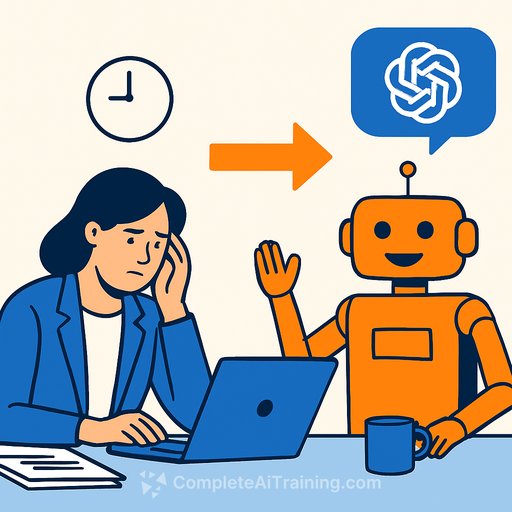The AI Boss Effect: Why Employees Ask ChatGPT Before Their Manager
Across roles and industries, employees are asking AI the questions they used to bring to their managers. For many, it's a daily habit. It feels safer, faster, and more useful.
Call it the AI Boss Effect: workers treat tools like ChatGPT as a trusted adviser-on tasks, decisions, and even emotions.
What the data says
A mid-2025 survey of 968 U.S. workers reports the shift in plain numbers. 97% have asked ChatGPT for advice instead of their manager; 63% do this regularly. 70% say it understands their work challenges better than their boss. Nearly half say AI is simply faster when they need an answer.
Usage is broad: 93% prep for manager conversations with it, 61% send messages it drafted, 57% use it to write or edit documents. Over half use it for brainstorming; 52% for coding; 40% for research and summarizing; 35% to draft before they revise.
The role isn't just tactical. 49% report AI has provided more emotional support than their manager during stressful periods. 77% say losing access would hurt productivity; 44% say it would seriously affect their performance. 72% rate its advice above their boss's. 56% believe it has doubled their productivity; only 2% see no impact.
Trust is nuanced. While individuals trust AI for personal guidance, 91% suspect AI has made unfair decisions at work. People want clarity on how employers deploy these systems.
Why your team prefers AI
- Less fear. 57% worry about retaliation for sensitive questions; AI feels safer.
- No judgment. 38% avoid asking managers to sidestep looking incompetent.
- Speed and availability. Instant responses beat calendar ping-pong.
- Perceived relevance. Many believe AI "gets" their day-to-day work better.
- Privacy. No politics, no hierarchy, no social cost.
How employees actually use it
- Message drafting, meeting prep, and rewriting for tone.
- Brainstorming ideas, outlining, and summarizing research.
- Coding and debugging, or checking logic on data tasks.
- Emotional regulation before tough conversations.
What this means for managers
This is a signal, not a threat. Employees aren't rejecting managers; they're choosing safety, clarity, and speed. Give them those-and they will come to you.
A management playbook you can apply this week
- Set an "Ask Anything" norm: No penalties for "basic" or sensitive questions. Publish a response-time promise.
- Office hours with purpose: Weekly 30-minute drop-in. Questions can be anonymous. Recap themes afterward.
- AI-first draft, human-final: Encourage AI for drafts; managers review for context, risk, and tone.
- Disclosure without stigma: Simple tag like "(AI-assisted draft)" on docs. Normalize it.
- Decision memos: For key calls, document problem, options, criteria, and rationale. Improves alignment and learning.
- Guardrails for safe use: Ban sensitive data in prompts, define acceptable tools, and teach verification. See the NIST AI Risk Management Framework.
- Coaching scripts for managers: Provide examples for feedback, conflict, and career talks. Reduce hesitation to "say the wrong thing."
- Training that sticks: Short sessions on prompt patterns, critique skills, and bias checks.
- Access strategy: Approve reliable AI tools. Provide a fallback for outages so work doesn't stall.
- Psychological safety rituals: Start meetings with a quick learning from failure. Normalize uncertainty and curiosity.
Prompts your team can borrow
- Manager prep: "Help me structure a 15-min conversation with my manager about X. Create a clear ask, context, risks, and next step."
- Draft to human tone: "Rewrite this update to be concise, neutral, and solution-focused. Keep it under 120 words."
- Decision check: "Given these options, list assumptions, risks, unknowns, and what data would change the decision."
- Emotional balance: "I'm stressed about X. Help me separate facts from stories and suggest a calm, professional response."
Metrics to watch
- Time-to-answer for common questions (AI vs. manager)
- Escalations per week and repeat questions
- Quality: accuracy issues caught in review
- Employee sentiment on safety, clarity, and trust
- Output stability during AI outages
Risks and how to reduce them
- Hallucinations: Require sources and a quick fact check for important work.
- Bias: Use structured criteria for decisions; audit samples regularly.
- Confidentiality: No sensitive data in prompts; use approved tools only.
- Over-dependence: Keep core skills sharp-writing, critical thinking, and direct manager dialogue.
- Fairness concerns: Be transparent about where AI is used in workflow and decisions.
If you lead people, here's the takeaway
The AI Boss Effect isn't about machines taking over management. It's a mirror. It reflects what employees need: safety, speed, clarity, and consistent support.
Let AI handle structure and quick drafts. Your job is trust, context, and judgment. Do that well, and people will use AI to work better-with you, not around you.
Level up your team's AI fluency
- AI courses by job role for targeted skill building across functions.
- Certification for ChatGPT to standardize prompt and review practices.
Your membership also unlocks:






